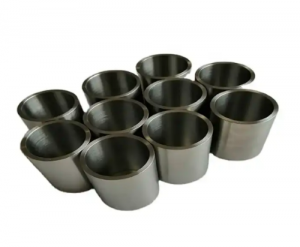Introduction
In the realm of materials research and synthesis, the pursuit of excellence is an enduring endeavor. Scientists and engineers constantly seek innovative methods and materials. Tantalum crucibles, in particular, have become indispensable tools in laboratories and industrial settings. It enables the creation of high-purity materials and advances various fields of science and technology. This article explores the vital role of tantalum crucibles in materials research and synthesis.

The Remarkable Properties of Tantalum
Tantalum, element 73 in the periodic table, is a rare, corrosion-resistant metal known for its exceptional properties. These properties make it uniquely suited for applications where high temperatures, chemical resistance, and ultra-high purity are essential.
First, tantalum is highly stable and immune to most forms of corrosion. It also boasts a melting point of approximately 3,020 degrees Celsius (5,468 degrees Fahrenheit). These attributes, along with its biocompatibility, make tantalum an invaluable resource for a wide range of applications.
The Birth of Tantalum Crucibles
Tantalum crucibles are typically made from high-purity tantalum metal, and they serve as containers for melting, growing, and processing various materials. They find extensive use in materials research and synthesis processes that demand extreme conditions. These crucibles play a crucial role in the production of superalloys, semiconductors, optical materials, and more.
Applications of Tantalum Crucibles
- High-Temperature Melting: Tantalum crucibles are ideal for melting and holding materials at ultra-high temperatures. They are commonly used in processes such as crystal growth and the production of superalloys. These processes are essential in aerospace and turbine engine applications.
- Chemical Inertness: Thanks to its exceptional corrosion resistance, Ta crucibles could handle reactive substances and produce high-purity materials in chemically aggressive environments.
- Semiconductor Industry: They are employed in the manufacture of semiconductors and optical materials to ensure the purity and reliability of these critical components.
- Metallurgy: Tantalum crucibles have a significant presence in metallurgy. It plays a pivotal role in the production of exotic and specialty metals and alloys.
- Glass and Ceramic Production: They are used in the creation of high-quality glass and ceramic materials, where high temperatures and chemical purity are prerequisites.
Conclusion
Tantalum crucibles have become essential tools in materials research and synthesis. With their exceptional resistance to high temperatures and corrosion, tantalum crucibles drive advancements in numerous fields. Whether it’s the production of semiconductors, superalloys, or specialty materials, these crucibles play a crucial role in pushing the boundaries of what is possible. They embody the crucible of excellence, serving as vessels of innovation, discovery, and the future of materials science.
Advanced Refractory Metals (ARM) is a trustful supplier of tantalum crucibles. Customization is also available. Send us an inquiry if you are interested.